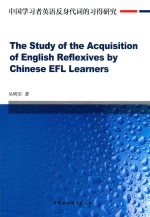图书介绍
中国学习者英语反身代词的习得研究PDF|Epub|txt|kindle电子书版本下载

- 吴明军著 著
- 出版社: 北京:中国社会科学出版社
- ISBN:9787520301237
- 出版时间:2017
- 标注页数:227页
- 文件大小:31MB
- 文件页数:255页
- 主题词:英语-代词-教学研究
PDF下载
下载说明
中国学习者英语反身代词的习得研究PDF格式电子书版下载
下载的文件为RAR压缩包。需要使用解压软件进行解压得到PDF格式图书。建议使用BT下载工具Free Download Manager进行下载,简称FDM(免费,没有广告,支持多平台)。本站资源全部打包为BT种子。所以需要使用专业的BT下载软件进行下载。如BitComet qBittorrent uTorrent等BT下载工具。迅雷目前由于本站不是热门资源。不推荐使用!后期资源热门了。安装了迅雷也可以迅雷进行下载!
(文件页数 要大于 标注页数,上中下等多册电子书除外)
注意:本站所有压缩包均有解压码: 点击下载压缩包解压工具
图书目录
Chapter One Introduction1
1.1 Introduction1
1.2 Referentiality in natural language2
1.2.1 Referentiality in human language2
1.2.2 Significance of the research on referentiality4
1.3 Referential characteristics of reflexives in English and Chinese7
1.3.1 Similarities in referential properties7
1.3.2 Distinct referential characteristics8
1.3.2.1 The difference in locality requirement8
1.3.2.2 The difference in orientation9
1.3.3 The logical problem with the acquisition of English reflexives10
1.4 UG and second language acquisition11
1.5 Organization of the dissertation14
Chapter Two Theoretical Foundations:The Binding Theory16
2.1 Introduction16
2.2 Types of determiner phrases17
2.3 The standard binding theory19
2.3.1 Binding19
2.3.2 Principle A of the standard binding theory21
2.3.3 Problems with the standard binding theory24
2.4 Modified versions of the standard binding theory25
2.4.1 Binding Principle A of the parameterized approach26
2.4.1.1 Governing Category Parameter and Proper Antecedent Parameter26
2.4.1.2 Criticisms of the parameterized approach28
2.4.2 Binding Principle A of the LF-movement approach29
2.4.2.1 Account of the long-distance binding30
2.4.2.2 Predictions for language acquisition33
2.4.2.3 Problems with the LF-movement approach33
2.4.3 Binding Principle A of the relativized SUBJECT approach36
2.4.3.1 Binding Principle A36
2.4.3.2 Long-distance effects37
2.4.3.3 Subject orientation39
2.4.3.4 Predictions for language acquisition40
2.4.3.5 Problems with the relativized SUBJECT approach41
2.5 The binding theory in the Minimalist Program(MP)43
2.5.1 Overview of the MP:Simplicity44
2.5.2 The phase theory45
2.5.3 Mechanisms of binding in the phase theory46
2.5.3.1 Derivational Binding Principle A46
2.5.3.2 Binding through ?-feature matching47
Chapter Three Previous Empirical Studies on Reflexives49
3.1 Introduction49
3.2 Studies on child language acquisition of reflexives51
3.2.1 L1 research within the framework of the parameterized approach52
3.2.1.1 Acquisition of reflexives with the local binding in the NL52
3.2.1.2 Acquisition of L1 reflexives with LD binding53
3.2.2 Reflexive and pronoun asymmetry54
3.2.3 Evidence supporting the relativized SUBJECT approach56
3.2.4 Developmental processes57
3.3 Studies on second language acquisition of reflexive binding60
3.3.1 Studies within the framework of the parameterized approach60
3.3.1.1 Finer&Broselow(1986)60
3.3.1.2 Finer(1991)63
3.3.1.3 Thomas(1989 and 1991a)65
3.3.1.4 Cook(1990)66
3.3.1.5 Hirakawa(1990)67
3.3.1.6 Eckman(1994)68
3.3.1.7 Lakshmanan&Teranishi(1994)68
3.3.2 Studies within the LF-movement approach69
3.3.2.1 Christie(1992)70
3.3.2.2 Thomas(1995)70
3.3.2.3 Yip&Tang(1998)71
3.3.2.4 Jiang(2009)72
3.3.3 Studies within the relativized SUBJECT approach73
3.3.3.1 Bennett(1994)73
3.3.3.2 MacLaughlin(1998)74
3.3.3.3 Wells(1998)75
3.4 An alternative account of the problematic acquisition:the Interface Hypothesis(IH)77
3.5 Summary78
Chapter Four Experimental Design and Method80
4.1 Introduction80
4.2 The mixed RM ANOVA design81
4.3 Procedure83
4.4 Materials83
4.4.1 Sentence Type 1:C-command85
4.4.2 Sentence Type 2:Orientation86
4.4.3 Sentence Type 3:Locality in the finite condition87
4.4.4 Sentence Type 4:Locality in the nonfinite condition87
4.4.5 Sentence Type 5:Locality in the PRNP condition87
4.5 Participants90
4.6 Research questions91
Chapter Five Data and Data Analyses93
5.1 Introduction93
5.2 Preliminary analysis94
5.2.1 The descriptive statistics94
5.2.2 The results of the mixed RM ANOVA98
5.3 Developmental patterns across binding properties101
5.3.1 The low group102
5.3.1.1 Aggregate results102
5.3.1.2 Individual results112
5.3.2 The mid group119
5.3.2.1 Group data119
5.3.2.2 Individual data126
5.3.3 The high group132
5.3.3.1 Group results132
5.3.3.2 Individual data139
5.4 Developmental patterns of binding properties through proficiency levels145
5.4.1 C-commanding requirement145
5.4.1.1 Aggregated data145
5.4.1.2 Individual results147
5.4.2 Orientation149
5.4.2.1 Aggregated data149
5.4.2.2 Individual results150
5.4.3 Locality:The finite condition151
5.4.3.1 Aggregated results152
5.4.3.2 Individual data154
5.4.4 Locality:The nonfinite condition155
5.4.4.1 Aggregated results156
5.4.4.2 Individual data158
5.4.5 Locality:The PRNP condition159
5.4.5.1 Aggregated results159
5.4.5.2 Individual data161
Chapter Six Discussion163
6.1 Introduction163
6.2 Main Results164
6.2.1 Development across binding properties164
6.2.2 Development through proficiency165
6.3 Crosslinguistic influence167
6.3.1 Positive transfer hypothesis168
6.3.2 The two-stage transfer:Accounting for the group differences169
6.3.3 Combinatory transfer of morphology of reflexives and AGR170
6.4 Direct accessibility of Universal Grammar171
6.4.1 L2 interlanguage grammars falling within the range sanctioned by UG172
6.4.2 Constraints of UG on interlanguage grammars174
6.4.2.1 The LF-movement account176
6.4.2.2 The parameterized approach177
6.4.2.3 The relativized SUBJECT analysis177
6.5 Asymmetries in locality:A phase-based approach179
6.5.1 Advanced L2 learners180
6.5.1.1 Reflexives in the vP Phase180
6.5.1.2 The DP phase183
6.5.2 Intermediate L2 learners184
6.5.3 Low proficiency learners184
6.5.3.1 Completeness of the vP phase185
6.5.3.2 Head of the phase:v vs.D185
6.6 Interface categories involved in Binding Principle A186
6.6.1 Acquisition of c-commanding condition:Pure syntax187
6.6.2 Acquisition of locality in the nonfinite clause:Syntax-lexicon interface188
6.6.3 Acquisition of locality in the PRNP condition:Syntax-semantics interface190
6.6.4 Acquisition of the object DP binding:Syntax-discourse interface192
Chapter Seven Conclusion195
7.1 Introduction195
7.2 Developmental patterns of L2 learners'acquisition of reflexives195
7.3 Theoretical and empirical implications196
7.4 Suggestions for future research198
Notes200
References202
Appendix:Individual results221
Abbreviations226